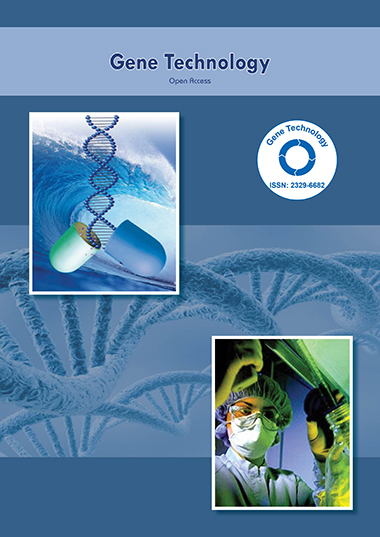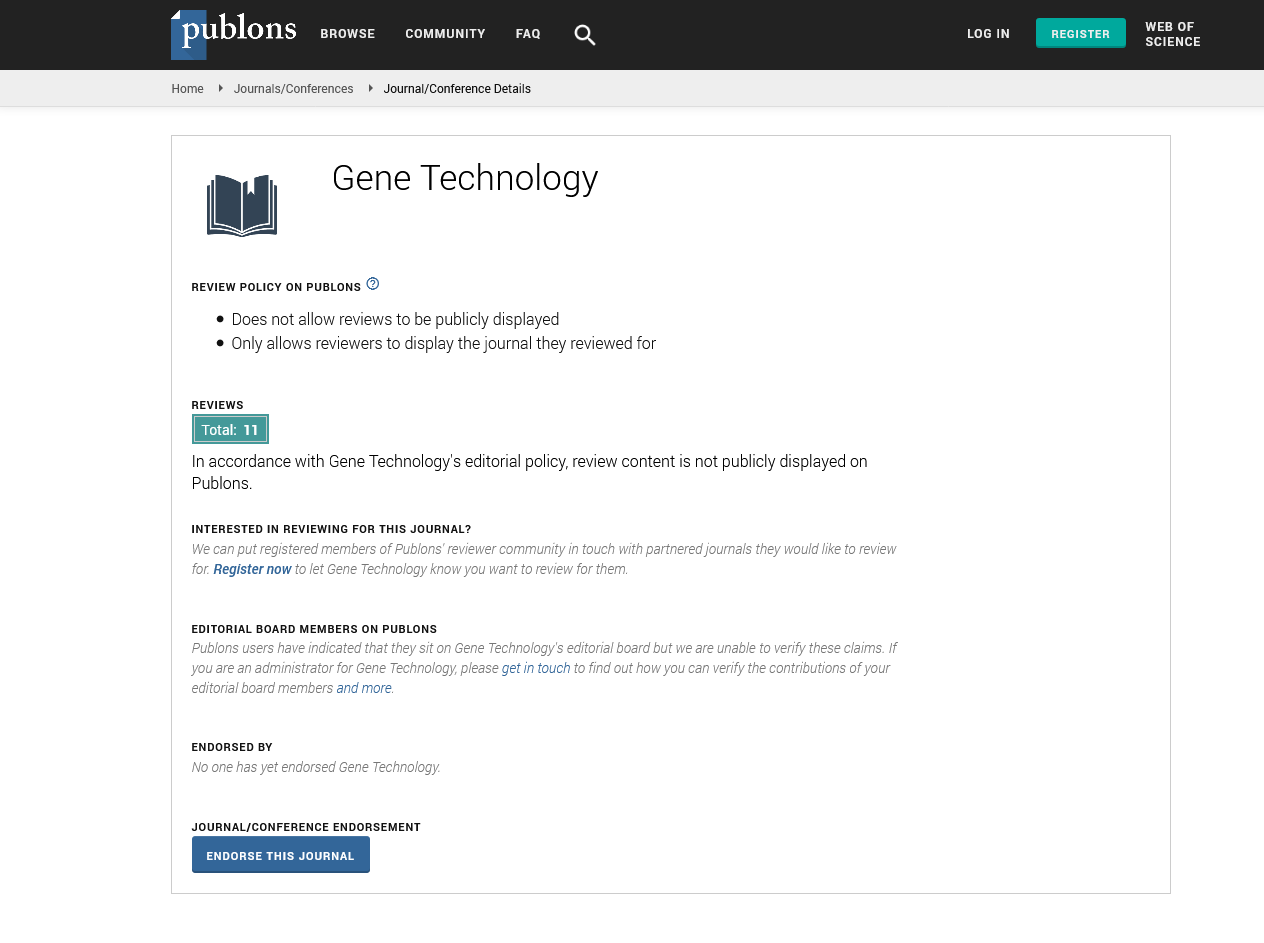Indexed In
- Academic Keys
- ResearchBible
- CiteFactor
- Access to Global Online Research in Agriculture (AGORA)
- RefSeek
- Hamdard University
- EBSCO A-Z
- OCLC- WorldCat
- Publons
- Euro Pub
- Google Scholar
Useful Links
Share This Page
Journal Flyer

Open Access Journals
- Agri and Aquaculture
- Biochemistry
- Bioinformatics & Systems Biology
- Business & Management
- Chemistry
- Clinical Sciences
- Engineering
- Food & Nutrition
- General Science
- Genetics & Molecular Biology
- Immunology & Microbiology
- Medical Sciences
- Neuroscience & Psychology
- Nursing & Health Care
- Pharmaceutical Sciences
Articles published in Gene Technology have been cited by esteemed scholars and scientists all around the world. Gene Technology has got h-index 6, which means every article in Gene Technology has got 6 average citations.
Following are the list of articles that have cited the articles published in Gene Technology.
| 2024 | 2023 | 2022 | 2021 | 2020 | 2019 | 2018 | 2017 | 2016 | 2015 | 2014 | 2013 | 2012 | |
|---|---|---|---|---|---|---|---|---|---|---|---|---|---|
Total published articles |
40 | 57 | 30 | 27 | 33 | 3 | 2 | 3 | 9 | 31 | 7 | 7 | 5 |
Research, Review articles and Editorials |
1 | 1 | 1 | 4 | 10 | 3 | 2 | 3 | 4 | 18 | 3 | 3 | 1 |
Research communications, Review communications, Editorial communications, Case reports and Commentary |
20 | 56 | 29 | 23 | 23 | 0 | 0 | 0 | 5 | 13 | 4 | 4 | 4 |
Conference proceedings |
0 | 0 | 0 | 0 | 0 | 0 | 0 | 0 | 0 | 0 | 0 | 0 | 0 |
Citations received as per Google Scholar, other indexing platforms and portals |
26 | 30 | 33 | 13 | 19 | 15 | 19 | 17 | 17 | 5 | 2 | 4 | 0 |
| Journal total citations count | 197 |
| Journal impact factor | 0.84 |
| Journal 5 years impact factor | 1.04 |
| Journal cite score | 1.03 |
| Journal h-index | 6 |
Important citations
Tongelen AV, Loriot A, De Backer O, De Smet C. Application of CRISPR/cas9-Directed Homologous Recombination to the Generation of Human Tumor Cells with Conditional Knockout of an X-Linked MicroRNA Locus. Gene Technology. 2015;4(124):2.
Laham-Karam N, Laitinen P, Turunen TA, Ylä-Herttuala S. Activating the Chromatin by Noncoding RNAs. Antioxidants & redox signaling. 2017 Aug 10.
Enhancing Angiogenesis in Mice by VEGF-Targeting Small Activating RNAs
Underutilised and neglected crops: next generation sequencing approaches for crop improvement and better food security
RNAi approach: a powerful technique for gene function studies and enhancing abiotic stress tolerance in crop plants
Plant Bioinformatics: Next Generation Sequencing Approaches
Alzahrani AN, Brigham FJ. Evaluation of Special Education Preparation Programs in The Field of Autism Spectrum in Saudi Arabia. INTERNATIONAL JOURNAL OF SPECIAL EDUCATION. 2017;32(4).
Mechanistic basis for increased human gene targeting by promoterless vectors—roles of homology arms and Rad54 paralogs
Construction and applications of exon-trapping gene-targeting vectors with a novel strategy for negative selection
Analysis of the role of homology arms in gene-targeting vectors in human cells
Ä°SLAMOVA F. Hashimoto tanılı olgularda sitotoksit t lenfosit iliÅŸkili PROTEÄ°N-4 (CTLA-4) ve selenoprotein S (SEPS1) gen polimorfizmlerinin incelenmesi (Master's thesis, Namık Kemal Üniversitesi).
Bire S, Casteret S, Arnaoty A, Piégu B, Lecomte T, Bigot Y. Transposase concentration controls transposition activity: myth or reality?. Gene. 2013 Nov 10;530(2):165-71.
De Filippis LF. Plant Bioinformatics: Next Generation Sequencing Approaches. InPlant Bioinformatics 2017 (pp. 1-106). Springer, Cham.
Li Y, Huang F, Lu Y, Shi Y, Zhang M, Fan J, Wang W. Mechanism of plant–microbe interaction and its utilization in disease-resistance breeding for modern agriculture. Physiological and molecular plant pathology. 2013 Jul 1;83:51-8.
Lucena Padrós H. Análisis de la diversidad microbiana asociada a la fermentación de aceitunas verdes de mesa por técnicas moleculares dependientes e independientes de cultivo.
Lucena-Padrós H, Ruiz-Barba JL. Diversity and enumeration of halophilic and alkaliphilic bacteria in Spanish-style green table-olive fermentations. Food microbiology. 2016 Feb 1;53:53-62.
Garneau MÈ, Posch T, Pernthaler J. Seasonal patterns of microcystin-producing and non-producing Planktothrix rubescens genotypes in a deep pre-alpine lake. Harmful algae. 2015 Dec 1;50:21-31.
Immunotherapy of cancer
Lee J, Rhee M, Min TK, Bang HI, Jang M,et al.(2016) A novel BTK gene mutation, c. 82delC (p. Arg28 Alafs* 5), in a Korean family with X-linked agammaglobulinemia. Korean Journal of Pediatrics 59:S49-S52.
Kang HS, Sung JS, Kim SH, Back HJ, Kim YO,et al.(2006) Frequency and clinical characteristics of prenatally diagnosed congenital hydronephrosis and outcomes of ureteropelvic junction stenosis. Korean Journal of Pediatrics 49:870-874.

